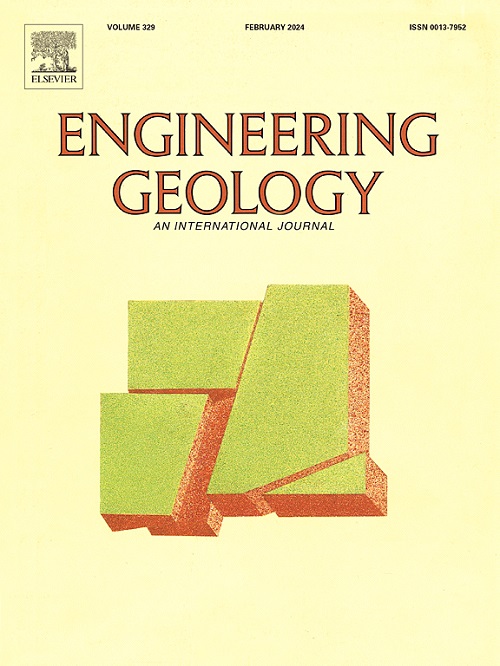Hydro-mechanical behavior and Cr(VI) containment performance of sand-clay-bentonite backfill
IF 8.4
1区 工程技术
Q1 ENGINEERING, GEOLOGICAL
引用次数: 0
Abstract
Vertical cutoff walls at heavy metal contaminated sites are subjected to coupled chemo-hydro-mechanical effects. In this study, a series of oedometer compression, permeability and solute transport tests were conducted to investigate the hydro-mechanical behavior and Cr(VI) containment performance of sand-red clay-bentonite backfill. Mercury intrusion porosimeter (MIP) and field emission scanning electron microscope (FESEM) were used to analyze microstructural changes following chemical exposure. Experiment results indicate that the backfill exhibited high compressibility, with a compression index of 0.74, and maintained a hydraulic conductivity below the regulatory threshold (< 10−9 m/s) under vertical effective stresses exceeding 25 kPa. Under Cr(VI) contamination, the backfill experienced slight shrinkage that correlated linearly with Cr(VI) concentration. This behavior is primarily attributed to the formation of localized sand skeletons, which enhance structural stability and chemical compatibility. Microstructural analyses revealed a reduction in micropore size due to clay aggregate shrinkage and an increase in macropore size caused by the formation of micro fissures at sand–clay interfaces. Consequently, hydraulic conductivity increased moderately (by 11 % to 50 %) with rising Cr(VI) concentration. This change corresponded to a gradual decline in containment performance, as evidenced by a reduced retardation factor and an increased hydraulic dispersion coefficient. Overall, the sand-red clay-bentonite backfill demonstrated low permeability and strong chemical compatibility under Cr(VI) contamination, making it a suitable backfill material for constructing vertical cutoff walls in Cr(VI)-contaminated sites.
砂-粘土-膨润土充填体水力学特性及Cr(VI)围堵性能
重金属污染场地的垂直截流墙受到化学-水-力学耦合效应的影响。为研究砂红粘土-膨润土充填体的水力学行为和Cr(VI)围堵性能,开展了一系列的压缩、渗透性和溶质输运试验。采用汞侵入孔隙度仪(MIP)和场发射扫描电镜(FESEM)分析化学暴露后的微观结构变化。试验结果表明,充填体具有较高的压缩性,压缩指数为0.74,水力导率低于调节阈值(<;(10−9m /s),垂直有效应力大于25kpa。在Cr(VI)污染下,充填体出现轻微收缩,收缩与Cr(VI)浓度呈线性相关。这种行为主要归因于局部砂骨架的形成,增强了结构稳定性和化学相容性。微观结构分析表明,粘土骨料收缩导致微孔尺寸减小,砂-粘土界面微裂隙形成导致大孔尺寸增大。因此,随着Cr(VI)浓度的升高,水导率适度增加(11% ~ 50%)。这种变化与遏制性能的逐渐下降相对应,滞缓系数的降低和水力分散系数的增加证明了这一点。总体而言,砂红粘土-膨润土充填体在Cr(VI)污染下表现出低渗透性和较强的化学相容性,是Cr(VI)污染场地垂直防渗墙的理想充填材料。
本文章由计算机程序翻译,如有差异,请以英文原文为准。
求助全文
约1分钟内获得全文
求助全文
来源期刊

Engineering Geology
地学-地球科学综合
CiteScore
13.70
自引率
12.20%
发文量
327
审稿时长
5.6 months
期刊介绍:
Engineering Geology, an international interdisciplinary journal, serves as a bridge between earth sciences and engineering, focusing on geological and geotechnical engineering. It welcomes studies with relevance to engineering, environmental concerns, and safety, catering to engineering geologists with backgrounds in geology or civil/mining engineering. Topics include applied geomorphology, structural geology, geophysics, geochemistry, environmental geology, hydrogeology, land use planning, natural hazards, remote sensing, soil and rock mechanics, and applied geotechnical engineering. The journal provides a platform for research at the intersection of geology and engineering disciplines.
 求助内容:
求助内容: 应助结果提醒方式:
应助结果提醒方式:


